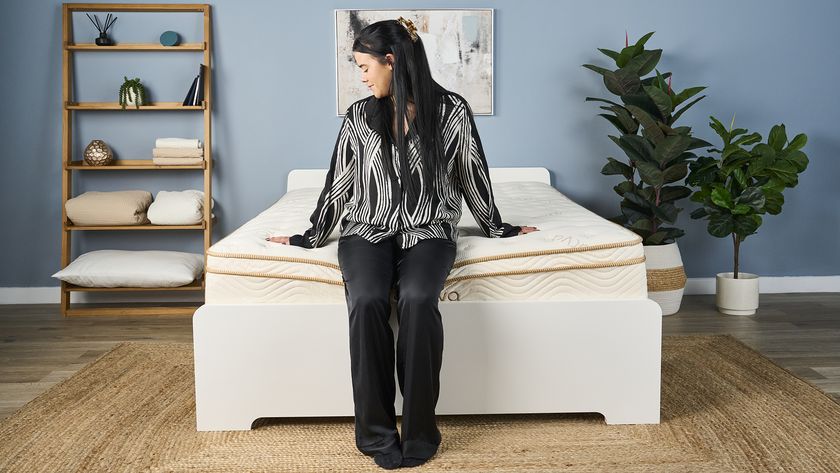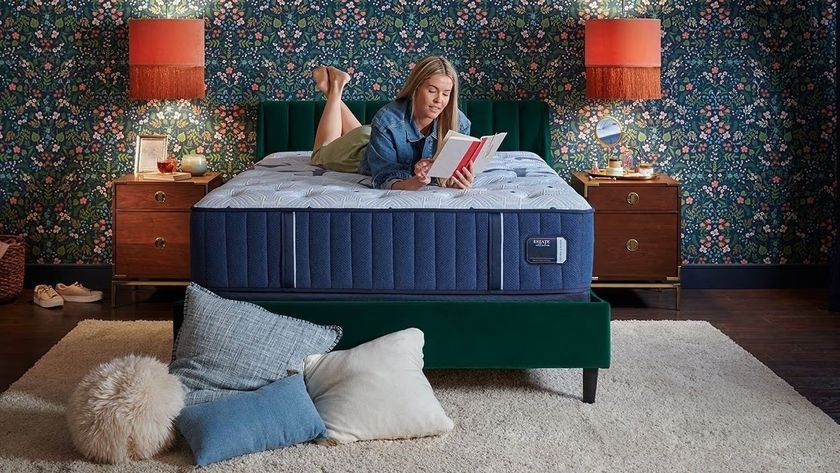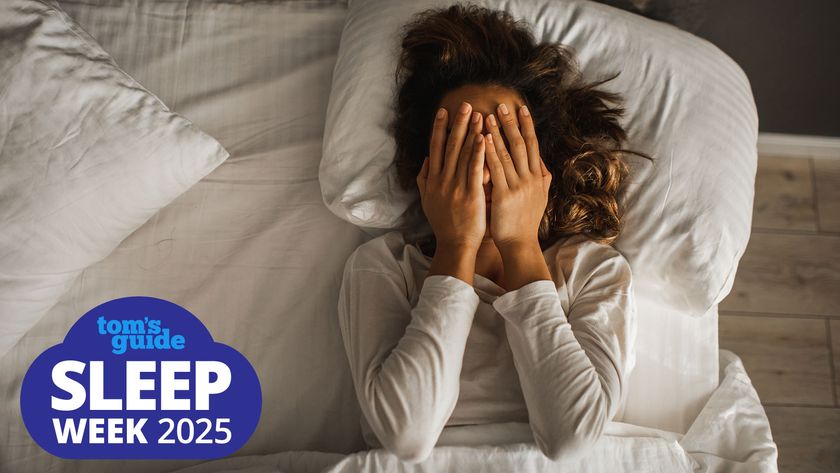What is a pocket sprung mattress?
Is a pocket sprung mattress your dream sleeping companion?

What is a pocket sprung mattress and is it the best choice for your sleeping requirements? Made with individually-wrapped pocket springs that work independently of one another, these mattresses provide sleepers with pressure relief where it’s needed.
Our best mattress guide includes mattresses with pocket springs, which are bouncier and firmer than memory foam mattresses. Pocket sprung mattresses offer a very different feel and are available in a variety of firmness options, although the most popular option is medium firm – balancing comfort and support perfectly. However, pocket sprung mattresses are often firm, meaning they’re also ideal for heavier sleepers.
Keep reading to learn all about pocket sprung mattresses to see if they're the right fit for your sleep needs and budget. And if it sounds like the kind of mattress you’ve been searching for, make sure you bookmark our guide to this year’s Labor Day mattress sales to see the biggest discounts on pocket sprung mattresses.
What is a pocket sprung mattress?
A pocket sprung mattress is made from individual pocket springs. Each of these pocket springs is enclosed within its own fabric pocket, which allows the springs to work independently from each other.
This advanced reaction from the springs allows for micro-adjustments to be made based on sleepers’ body shape, sleeping position and overnight movements. And, because the coils are individually wrapped, there are a far wider range of options for comfort layers.
The main benefits of a pocket sprung mattress are tailored support, spinal alignment, minimal motion transfer (good for co-sleepers), pressure relief and consistent firmness.
How much do pocket sprung mattresses cost?

A pocket sprung mattress is normally more expensive than a memory foam mattress but can be found more cheaply than a hybrid. However, this all depends on the number of springs in the mattress and the materials used as a comfort layer. You’ll also pay considerably more for one of the best organic mattresses on the market
There is a huge variety of pocket sprung mattresses on the market in both the UK and the US and, as with most types of mattresses, there’s also a huge price range. In the US you can buy a queen size Allswell mattress for as little as $449 or the ever-popular DreamCloud Luxury Hybrid for $999, also in queen. At the top end of the scale, you could pay well over $5,000 for a Hypnos pocket spring mattress.
Prices are comparable in the UK. Silentnight make a huge range of popular mattresses, with prices starting at around £400 for a double pocket sprung mattress with 1,200 springs. Sealy’s pocket sprung mattresses are around £570, with Hypnos also being available in the UK for far more reasonable prices (starting at around £1600 for a double).
On either side of the Atlantic, regularly browsing ongoing mattress sales will help you save money on a brand new pocket sprung mattress.
What are pocket sprung mattresses made of?

Perhaps more so than any other type of mattress, pocket sprung mattresses can contain a variety of different materials alongside the pocket springs themselves. Comfort materials can range from cheaper sustainable fibers up to natural wool, memory foam and latex. As you might expect, the more money you pay for your mattress, the more layers you’re likely to have.
Despite the variety, most pocket sprung mattresses follow a similar pattern in construction. Common components include:
- A breathable cover – Covers are commonly made from quilted foam and designed to keep the sleeper cool at night, as well as providing a comfortable sleeping surface. Cheaper mattresses will often have the cover stitched to the mattress.
- A comfort layer – At the cheaper end of the scale this layer will consist of eco comfort fibers but, as you rise up the price scale, expect to find materials including memory foam, gel memory foam, wool and latex. You rest on this layer, which helps contour the body for a comfortable night’s sleep. More expensive pocket sprung mattresses may have multiple comfort layers.
- Pocket springs – A layer of individually wrapped pocket springs, designed to adjust independently to a sleeper’s movements throughout the night and provide pressure relief. Again, more expensive pocket sprung mattresses may have more than one layer of springs.
- A protective layer – Pocket sprung mattresses often have a protective layer beneath the springs to ensure that the structure of the mattress is protected while you sleep on it.
- The base – The base of the mattress is a solid layer, often of polyfoam, that provides support to the entire mattress.
Are pocket sprung mattresses comfortable to sleep on?
Mattresses are not ‘one size fits all’. Different people enjoy sleeping on different mattresses, plus your sleeping position and body weight will play a huge part in the type of mattress you find comfortable. For more on that subject, read our guide on how to choose the right mattress for your body and sleep style.
Pocket sprung mattresses suit a larger variety of body weights than many other types of mattress because they are generally available in a wide range of firmness ratings. However, this is dependent on them having a good quality comfort layer – particularly when it comes to heavier sleepers. The neutral spinal alignment that pocket springs promote means that these mattresses can be extremely supportive for all sleeping positions, although we think back and combo sleepers will particularly enjoy them.
Hot sleepers should look for a mattress with added cooling materials such as gel memory foam. The DreamCloud mattress contains gel memory foam for additional cooling, for example.
How long do pocket sprung mattresses last?

On average, a pocket sprung mattress will last around 7-10 years. Of course, this does depend on specific factors:
- How you take care of the mattress
- The combined body weight sleeping on the mattress
- How much use it gets
- How well cushioned the springs are
- How well made the mattress is
Most pocket sprung mattresses have a warranty of around 10 years, although cheaper versions may only be 3-5 years. A few mattresses, such as the DreamCloud Luxury Hybrid (containing pocket springs), have a lifetime warranty. This is not the norm though. The mattress warranty can be an indication of how long a manufacturer expects a mattress to last.
Another useful factor for the customer with most modern mattresses is the fact that manufacturers offer a mattress trial, where you can try the mattress out for a certain number of nights in your home. As well as helping you decide whether the mattress is the right fit for you, a trial can also give you a good indication of how sturdy you feel the bed will be.
Do pocket sprung mattresses need a box spring?
Unlike older innerspring mattresses, modern pocket sprung mattresses don’t need a box spring. In fact, pocket sprung mattresses generally work well on a variety of bed frames. However, the optimum base for a pocket sprung mattress has a solid foundation, such as a platform bed frame. A solid foundation works well with the individual springs, helping to keep a sleeper’s weight evenly distributed as well as relieving pressure points.
We also recommend that you check your manufacturer’s guidelines for bed bases – using a style they don’t recommend could even void your warranty.
- Read more: How do mattress warranties work?
Who should buy a pocket sprung mattress?
Pocket sprung mattresses are some of the most versatile beds on the market. They suit a variety of sleeping positions and come in a range of firmness ratings. They’re a good choice for the majority of sleepers but we’d recommend them in particular for:
- Back, side and front sleepers, who will all benefit from the zoned support of the coils that supports spinal alignment.
- Combination sleepers who want the bounce of the springs to easily change position throughout the night.
- Those who want a bed with minimal motion transfer, as the springs flex to absorb movement.
- Those suffering from aches and pains, who will find that the individually wrapped springs offer great pressure relief.
Who shouldn’t buy a pocket sprung mattress?
On the flip side of that, who shouldn't buy a pocket sprung mattress? As we mentioned earlier, mattresses aren’t a ‘one size fits all’ product and pocket sprung mattresses won’t suit everyone. Although we think they’re one of the best all-rounders, a pocket sprung mattress might not suit you if:
- You are of a very light weight and need more cushioning.
- You want a mattress that ‘hugs’ you and contours more closely to your body.
- You sleep hot as the springs are each wrapped in a fair amount of material which prevents airflow.
- You weigh over 250lbs as you may find that you sink too far into the mattress and the springs cause discomfort.
What is a pocket sprung mattress: Summary

Pocket sprung mattresses contain individual pocket springs which are each enclosed in their own fabric pocket. The springs work independently from each other, allowing for zoned support, spinal alignment, minimal motion transfer, excellent pressure relief and a sleeping surface that suits the vast majority of sleeping styles.
If money is no object, then brands such as Hypnos have been making pocket sprung mattresses for years, producing exquisite mattresses with high quality materials. But there are plenty of choices to suit all budgets – from brands such as Silentnight in the UK and Allswell in the US. Prices start at around $400 for a queen up to over $5000 in the US and around £400 for a double to over £2000 in the UK.
For most types of sleepers, a mattress with pocket springs will provide the right balance of comfort and support. However, you'll still want to try it out and give your body time to adjust. Fortunately, the most popular pocket sprung mattresses include a risk-free trial lasting several months, with hassle-free returns in case it doesn't work out.
Time to upgrade? We recommend the following...
Read more:
- Complement your mattress with the best pillow for your sleep needs
- DreamCloud vs Saatva: which luxury hybrid mattress should you buy?
- Pick up the best mattress protector to help your bed last longer
- Learn how the best mattress toppers can make your bed comfier
Sign up to get the BEST of Tom's Guide direct to your inbox.
Get instant access to breaking news, the hottest reviews, great deals and helpful tips.

Claire is a fully qualified journalist and Certified Sleep Science Coach with over 15 years’ product review experience. Claire is responsible for all mattress and sleep content published on Tom’s Guide, including our Best Mattress of 2025 buying guide. She is our expert on Saatva, DreamCloud, Nectar and Tempur-Pedic mattresses, and is also our in-house hybrid mattress specialist. Claire is certified to advise people on how to choose a mattress that best suits their sleep, body and budget, as well as helping them to create a nighttime routine and bedroom environment that promote good sleep. As Senior Sleep Editor, Claire takes the lead on developing and overseeing rigorous testing procedures for our mattress reviews, both at home and in our fully equipped Sleep Studio. Claire leads a team of experienced sleep and mattress specialists who report on and test a wide range of mattress and sleep products, and she also writes about all things related to sleep, and has interviewed a wealth of experts including mattress designers and buyers, neuroscientists, and doctors of sleep medicine.






















